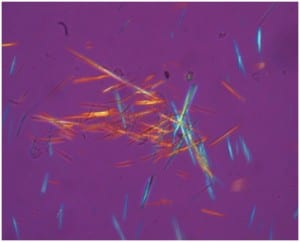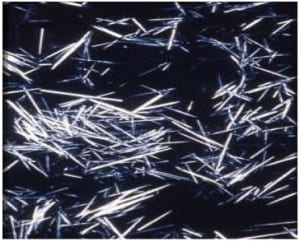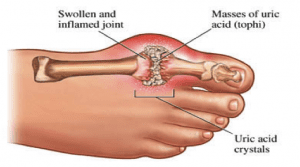Causes and Symptoms
There are many gout causes and gout symptoms that are linked to gout but it is normally attributed to a higher level of uric acid in the body which over time if not expelled sufficiently, forms needle like crystals in the joints. If you suffer from gout your body at times can’t expel the uric acid effectively and this build-up of uric acid creates the condition called Gout, Gouty Arthritis or Tophi.What Is Uric Acid?
A test for uric acid in the blood will not show the amount of uric acid that is crystallized in connective tissue waiting to cause the next acute attack. Through the breakdown of purine, a substance found in many foods including the likes of shell food, red meat, beer and sugary drinks, uric acid is produced.
Once uric acid is produced, it travels in your blood and passes through your kidneys. In some people, the kidneys may have a difficult time removing uric acid from the blood normally. As a result, the level of uric acid within the blood increases.
What is Uric Acid crystals
Humans excrete a nitrogenous waste, uric acid. It is the product of nucleic acid, not a protein, of the metabolism. Uric acid is only slightly soluble in water and may precipitate out of a solution contributing to the formation of kidney stones. Uric acid may also form needle-like crystals in one or more joints producing the excruciating pain of an acute gout attack.
Curiously, our kidneys reclaim most of the uric acid filtered at the glomeruli. Why, if it can cause problems? Uric acid is a potent antioxidant and thus can protect cells from DNA damage. The risk of kidney stones and gout may be the price we pay for this protection.
Our herbal blend (GC®) helps the body regulate this process and helps maintain a normal level of uric acid in the blood. The herbs combine with the uric acid to help it remain soluble. With just a small change in diet, a person will be able to eat a complete variety of foods and remain gout free.


What is Gout?
Gout was originally known as the ‘disease of kings”, and was bought on from a ‘gout diet’ rich in purines such as red meat, shell food and beer.Gout is also thought to be hereditary or come from certain aliments in the body, namely the kidneys. About 3-5% of the population are affected by gout, and it mostly affects men in the 40 + age bracket, but can strike at any age and is less common in women. It is more common in Maori and people of island decent.If the body can’t expel all the uric acid, over time it can take on the form of needles when it crystallizes in the joint tearing into the synovial fluid sacks and cartilage. The body then attacks the problem with the white blood cells causing the inflammation to a point where it is considered an acute gout attack. Excess uric acid can also cause a mild ache in the joints without the accompanying attack. This acid crystal build up in the joints is referred to as gout, gouty arthritis or tophi. Gouty arthritis ( Gout for short ) can be excruciatingly painful, often striking at night and keeping some people bedridden for days. Gout symptoms generally affect the joints including swelling, warmth; redness and can make them extremely sensitive to touch. Gout causes a build-up of uric acid in the connective tissue of the joints and areas commonly affected are the big toe, the instep, ankle, knee, wrist, elbow and fingers. If the build-up of these acid crystals isn’t treated, it commonly leads to more gout attacks. If a person has had more than 2 gout attacks then it is more likely to become an ongoing issue. It is highly probable that other joints in the body will also be affected at some stage if the underlying issue and gout symptoms aren’t resolved with a suitable gout treatment. If uric acid levels remain raised for long periods of time, or there are frequent recurrent attacks of gout, deposits of uric acid salts may appear around the affected joint. These are called tophi and appear as chalky colored nodules. Tophi may also appear in other areas of the body such as the ears. This is why at early stages or symptoms of gout it is important to treat it and remove the build-up with a suitable gout treatment. Gout is a progressive disorder and the longer it goes untreated the higher the likely hood of it getting worse. If untreated the longer term consequences of gout and gouty arthritis can also lead to other medical conditions including high blood pressure, diabetes can increase the risk of heart disease, stroke and long-term kidney failure.
This acid crystal build up in the joints is referred to as gout, gouty arthritis or tophi. Gouty arthritis ( Gout for short ) can be excruciatingly painful, often striking at night and keeping some people bedridden for days. Gout symptoms generally affect the joints including swelling, warmth; redness and can make them extremely sensitive to touch. Gout causes a build-up of uric acid in the connective tissue of the joints and areas commonly affected are the big toe, the instep, ankle, knee, wrist, elbow and fingers. If the build-up of these acid crystals isn’t treated, it commonly leads to more gout attacks. If a person has had more than 2 gout attacks then it is more likely to become an ongoing issue. It is highly probable that other joints in the body will also be affected at some stage if the underlying issue and gout symptoms aren’t resolved with a suitable gout treatment. If uric acid levels remain raised for long periods of time, or there are frequent recurrent attacks of gout, deposits of uric acid salts may appear around the affected joint. These are called tophi and appear as chalky colored nodules. Tophi may also appear in other areas of the body such as the ears. This is why at early stages or symptoms of gout it is important to treat it and remove the build-up with a suitable gout treatment. Gout is a progressive disorder and the longer it goes untreated the higher the likely hood of it getting worse. If untreated the longer term consequences of gout and gouty arthritis can also lead to other medical conditions including high blood pressure, diabetes can increase the risk of heart disease, stroke and long-term kidney failure.What about Gout and Stress?
Long before the body’s reaction to stress was understood, medical dictionaries listed ‘poor man’s gout’ as being caused by hard work, exposure, poor feeding and excessive use of alcohol.
It is now recognized that attacks of gout can occur immediately after some form of stress and the millions of body cells destroyed during this alarm reaction free up large quantities of uric acid, which may be neutralised by sodium and shunted into the tissues. An inadequate diet alone and a lack of vitamin B can impose enough stress to cause gout.
Since gout occurs in families, people subject to this disease may have hereditarily high requirement for pantothenic acid and other nutrients necessary to protect the body from stress. Any form of stress quickly exhausts the supply of pantothenic acid, thus preventing uric acid from being changed to urea, therefore uric acid accumulates, resulting in a gout attack.
GC®’s Body Boost multivitamin is a good source of the B5 and that together with other vitamins helps keep the uric acid levels intact, and aids the body to recover better when under stress.
Gouty Arthritis
Gouty arthritis can be excruciatingly painful, often striking at night and keeping some people bed ridden for days. Gout symptoms generally affect the joints including swelling, warmth; redness and can make them extremely sensitive to touch. Gout causes a build-up of uric acid in the connective tissue of the joints and areas commonly affected are the big toe, the instep, ankle, knee, wrist, elbow and fingers.
The Four Stages of Gout
Stage One
Sometimes uric acid problems are even misdiagnosed as Rheumatoid Arthritis. The uric acid crystals will cut into the synovial fluid sacks that cushion all joints releasing the synovial fluid into the blood. This can cause blood readings to indicate Rheumatoid Arthritis when in fact the problem is uric acid crystals.
Stage Two
Stage Three
Stage Four
What Wikipedia Says
In the United States, gout is twice as likely in African American males as it is in European Americans. Rates are high among the peoples of the Pacific Islands and the Māori of New Zealand, but rare in Australian Aborigines, despite a higher mean concentration of serum uric acid in the latter group. It has become common in China, Polynesia, and urban sub-Saharan Africa. Some studies have found attacks of gout occur more frequently in the spring. This has been attributed to seasonal changes in diet, alcohol consumption, physical activity, and temperature.
Gout can present in a number of ways, although the most usual is a recurrent attack of acute inflammatory gouty arthritis (A red, tender, hot, swollen joint). The metatarsal-phalangeal joint at the base of the big toe is affected most often, accounting for half of cases. Other joints, such as the heels, knees, wrists and fingers, may also be affected. Joint pain usually begins over 2–4 hours and during the night. The reason for onset at night is due to the lower body temperature then.[1] Other symptoms may rarely occur along with the joint pain, including fatigue and a high fever.
High levels of uric acid in the blood (Hyperuricemia) is the underlying cause of gout. This can occur for a number of reasons, including diet, genetic predisposition, or under excretion of urate, the salts of uric acid.The occurrence of gout is partly genetic, contributing to about 60% of variability in uric acid level. Gout frequently occurs in combination with other medical problems. Metabolic syndrome, a combination of abdominal obesity, hypertension, insulin resistance and abnormal lipid levels, occurs in nearly 75% of cases. Chronic lead exposure and lead-contaminated alcohol are risk factors for gout due to the harmful effect of lead on kidney function. Hyperuricemia is a classic feature of gout, but it occurs nearly half of the time without hyperuricemia.
Dietary and lifestyle choices that are effective include reducing intake of food such as meat and seafood, consuming adequate vitamin C, limiting alcohol and fructose consumption, and avoiding obesity. but some of the increased risk appears to be independent. Without treatment, an acute attack of gout usually resolves in five to seven days; however, 60% of people have a second attack within one year. Without a gout treatment, the early gout symptoms and episodes of acute gout may develop into chronic gout with the destruction of joint surfaces, joint deformity, and painless tophi. These tophi occur in 30% of those who are untreated for five years, often in the helix of the ear, over the olecranon processes, or on the Achilles tendons. With aggressive treatment, they may dissolve. Kidney stones also frequently complicate gout, affecting between 10 and 40% of people, and occur due to low urine pH promoting the precipitation of uric acid. Other forms of chronic renal dysfunction may occur. End of Wikipedia information
Prescription Alternatives – Prescription Medicines and Gout
Allopurinol
Of over the counter and gout related prescription medicines, allopurinol is one of the more popular gout related prescription medicines available. Check out this video about what a doctor has to say about taking allopurinol :
*Results are not guaranteed and will differ from person to person.
Allopurinol ( Zyloprim) has also been shown to have many potential side effects including, skin rashes, allergic reactions including vomiting, fever, chills, nausea, abdominal pain and diarrhea. It is also known when you start taking allopurinol that it may actually increase the chance of more gout attacks? Isn’t this the reason you’re taking it ? To stop gout attacks, not create more?! Apparently you also need to discuss the chances of stroke and heart attack with your doctor while taking allopurinol. Doesn’t it seem odd that Doctors are actually prescribing such gout treatments?
Prescription gout treatment is not typically advised for asymptomatic hyperuricemia (high uric acid levels with no gout attack symptoms). These traditional gout drugs should only be prescribed by informed doctors, in the presence of gout attacks or kidney stones. The undesired side effects associated with these gout drugs, and the damage that they may do to the organs, does not warrant their use based solely on elevated uric acid levels in the blood. GC® GoutCare, on the other hand, can be used by both gout sufferers and people with high blood levels of uric acid. GC® is safe and only has beneficial side effects from its use, for anyone with or without uric acid problems. In fact, GC® has a positive effect on type two Diabetics by aiding to lower their insulin needs. It is even possible to control borderline cases in hopes of remaining off insulin altogether.
ALLOPURINOL
COLCHICINE
ALLOPURINOL (also called Zyloprim)
A recent randomized, double-blind, placebo-controlled study of the early initiation of full-dose allopurinol (300 mg) versus placebo in adults with acute gout attacks reports no statistically significant difference in mean visual analogue scale (VAS) pain scores between patients started on allopurinol versus patients started on placebo on day 1 of the acute attack. The reported mean VAS scores for the allopurinol group versus the placebo group were recorded on day 1 and day 10 of the study and were as follows; Day 1: 6.72 and 6.28 respectively (P 0.37), Day 10: 0.18 and 0.27 respectively, (P 0.54). The study also reports no statistically significant difference in the rate of new or recurrent gout flares between the allopurinol group versus the placebo group over a 30 day period. In the allopurinol group the rate of new or recurrent attacks was 2 of 26 (7.7%), and in the placebo group the rate was 3 of 25 (12.0%) (P 0.61).
Side-effects:
Because allopurinol is not a uricosuric, it can be used in patients with poor kidney function. However, allopurinol has two important disadvantages.
First, its dosing is complex. Second, some patients are hypersensitive to the drug, therefore its use requires careful monitoring. Allopurinol has rare but potentially adverse effects involving the skin. The most serious adverse effect is a hypersensitivity syndrome consisting of fever, skin rash, eosinophilia, hepatitis, worsened renal function, and, in some cases, allopurinol hypersensitivity syndrome.
Allopurinol is one of the drugs commonly known to cause Stevens–Johnson syndrome (SJS) and toxic epidermal necrolysis (TENS), two life-threatening dermatological conditions. More common is a less-serious rash that leads to discontinuing this drug. Studies have found HLA-B*5801 allele as a genetic marker for severe cutaneous adverse reactions that include Steven Johnson Syndrome and toxic epidermal necrosis caused by allopurinol.
More rarely, allopurinol can also result in the depression of bone marrow elements, leading to cytopenias, as well as aplastic anemia. Moreover, allopurinol can also cause peripheral neuritis in some patients, although this is a rare side effect. Another side effect of allopurinol is interstitial nephritis.[23]
It is suspected to cause congenital malformations when used during pregnancy, and should be avoided whenever possible by women trying to conceive.
Dextrothyroxine (trade name Choloxin) saw research as an cholesterol-lowering drug but was pulled due to cardiac side-effects. It also increases hepatic lipase which in turn improves utilization of triglycerides, improving apo lipoprotein E cholesterol particles.
Antibiotics
When used by a person who suffers with high uric acid it can be a problem. Antibiotics kills friendly bacteria in the digestive system and since the bowels account for about 30% of the uric acid elimination in our bodies, a uric acid build in the blood may happen when on antibiotics.
The antibiotics seem to inhibit the elimination of uric acid from the bowel system due to the bacteria not being present. It also may hamper the herbal blend from being absorbed fully into the system, due to the elimination of the lactobacillus-bifidus / acidophilus by the antibiotics. Therefore a person using our herbal blend and has a need to take antibiotics must be very careful with their diet during and after its use. The person also should consume extra sour dairy and acidophilus / bifidus pills during and after to re-establish a proper working bowel system before they indulge in foods high in purines again.
